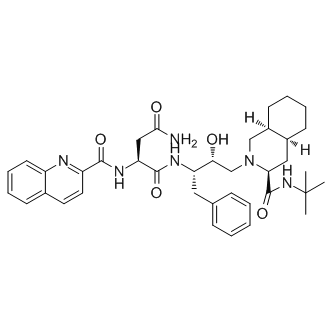| Reference | <p style=/line-height:25px/>
<br>[1]. Barillari Giovannia, Iovane Andréa, Bacigalupo Ilariaa, et al. Ritonavir or saquinavir impairs the invasion of cervical intraepithelial neoplasia cells via a reduction of MMP expression and activity. AIDS. 2012, 26 (8): 909-919.
Abstract
Objective and design: Treatment of human immunodeficiency virus (HIV)-infected women with the highly active antiretroviral therapy (HAART) has reduced the onset of uterine cervical intraepithelial neoplasia (CIN), and halted its progression to cervical carcinoma. We and others demonstrated that the HIV protease inhibitors (HIV-PIs) used in HAART can exert direct antitumour activities also in HIV-free preclinical or clinical models. As uterine cervical carcinoma is a leading cause of death in women independently of HIV infection, herein we assessed the impact of therapeutic concentrations of HIV-PIs including indinavir (IDV), saquinavir (SQV) or ritonavir (RTV) on cells obtained from CIN or cervical carcinoma lesions of HIV-negative women. Methods: HIV-PI effects were evaluated by cell invasion, growth or toxicity assays, and by RNA, protein or zymogram analyses. Results: Both SQV and RTV inhibited CIN cell invasion, and this was paralleled by a reduced expression and proteolytic activity of the matrix metalloproteinase (MMP)-2 and 9 in treated cells. SQV and RTV also reduced CIN cell growth rate, but did not affect the invasion or growth of cells derived from highly progressed cervical carcinoma. Conclusion: As MMP-2 and MMP-9 have a key role in CIN evolution into cervical carcinoma, these results support the use of SQV or RTV for the block of CIN clinical progression in either HIV-infected or uninfected patients.
<br>[2]. Martha Stefanidou, Carolina Herrera, Naomi Armanasco et al. Saquinavir Inhibits Early Events Associated with Establishment of HIV-1 Infection: Potential Role for Protease Inhibitors in Prevention. Antimicrob. Agents Chemother. 2012, 56 (8): 4381-4390.
Abstract
The maturation of newly formed human immunodeficiency virus type 1 (HIV-1) virions is a critical step for the establishment of productive infection. We investigated the potential of saquinavir (SQV), a protease inhibitor (PI) used in highly active antiretroviral therapy (HAART), as a candidate microbicide. SQV inhibited replication of clade B and clade C isolates in a dose-dependent manner in all cellular models tested: PM-1 CD4 T cells, peripheral blood mononuclear cells (PBMCs), monocyte-derived macrophages (MDMs), and immature monocyte-derived dendritic cells (iMDDCs). SQV also inhibited production of infectious virus in cervical, penile, and colorectal explants cocultured with T cells. Moreover, SQV demonstrated inhibitory potency against trans infection of T cells by in vitro-derived dendritic cells and by primary dendritic cells that emigrate from penile and cervical tissue explants. No cellular or tissue toxicity was detected in the presence of SQV, suggesting that this drug could be considered for development as a component of an effective microbicide, capable of blocking viral maturation and transmission of HIV-1 at mucosal surfaces.
<br>[3]. Marco Donia, Danijela Maksimovic-Ivanic, Sanja Mijatovic, et al. In vitro and in vivo anticancer action of Saquinavir-NO, a novel nitric oxide-derivative of the protease inhibitor saquinavir, on hormone resistant prostate cancer cells. Cell cycle. 2011, 10(3): 492 – 499.
Abstract
The NO-derivative of the HIV protease inhibitor saquinavir (Saq-NO) is a nontoxic variant of the parental drug with enhanced anticancer activity on several cell lines. However, it is still unclear whether the p53 status of the target cell might influence the sensitivity to Saq-NO. In this study we evaluated the in vitro and in vivo activity of Saq-NO on the p53-deficient hormone resistant prostate cancer PC-3 cells. We demonstrate that the absence of functional p53 is not essential for the capacity of Saq-NO to reduce prostate cancer cell growth. In contrast to its previously described cytostatic action in B16 and C6 cell lines, Saq-NO exerted cytotoxic effects in PC-3 cells leading to dominant induction of apoptosis and enhanced production of proapoptotic Bim. In addition, differently from saquinavir, Saq-NO restored TRAIL sensitivity that was correlated with increased expression of DR5 independent from ROS/RNS production and YY1 repression. NF-κB activation may be responsible of the Saq-NO induced DR5 expression. Moreover, Saq-NO but not saquinavir, exerted synergistic activity with conventional cytostatic therapy. In agreement with these in vitro studies, Saq-NO inhibited the in vivo growth of PC-3 cells xenotransplants to a greater extent than the parental compound. Taken together, these data indicate that Saq-NO possesses powerful and suitable in vitro and in vivo chemotherapeutic potential to be further studied as a novel drug for the treatment of prostate cancer in the clinical setting.
<br>[4]. Walmsley Sharon, Avihingsanon Anchalee, Slim Jihad et al. Gemini: A Noninferiority Study of Saquinavir/Ritonavir Versus Lopinavir/Ritonavir as Initial HIV-1 Therapy in Adults. JAIDS Journal of Acquired Immune Deficiency Syndromes. 2009,50 (4) :367-374.
Abstract
Introduction: Direct comparison of the efficacy and safety of different agents is needed to guide selection of optimal treatment regimens for therapy-naive HIV-1-infected patients. Methods: Gemini was a 48-week, multicenter, open-label, noninferiority trial in treatment-naive HIV-1-infected adults randomized to either saquinavir/ritonavir (SQV/r) 1000 mg/100 mg twice a day or lopinavir/ritonavir (LPV/r) 400 mg/100 mg twice a day, each with emtricitabine/tenofovir 200 mg/300 mg every day. Results: A similar proportion of participants in the SQV/r (n = 167) and LPV/r (n = 170) arms had HIV-1 RNA levels <50 copies per milliliter at week 48: 64.7% vs 63.5% and estimated difference in proportion for noninferiority: 1.14%, 96% confidence interval: -9.6 to11.9 (P < 0.012), confirming that SQV/r was noninferior to LPV/r treatment. There were no significant differences in week 48 CD4 counts between arms. The rate and severity of adverse events were similar in both groups. There were no significant differences in the median change from baseline between arms in plasma lipids except for triglyceride levels, which were significantly higher in the LPV/r at week 48. Conclusions: In treatment-naive, HIV-1-infected patients, SQV/r treatment was noninferior in virologic suppression at 48 weeks to LPV/r treatment and offered a better triglyceride profile.
<br>[5]. Saquinavir
</p>
|

